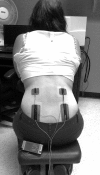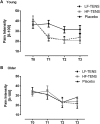High- and low-frequency transcutaneous electrical nerve stimulation does not reduce experimental pain in elderly individuals
- PMID: 26101836
- PMCID: PMC4770382
- DOI: 10.1097/j.pain.0000000000000276
High- and low-frequency transcutaneous electrical nerve stimulation does not reduce experimental pain in elderly individuals
Abstract
Despite its widespread clinical use, the efficacy of transcutaneous electrical nerve stimulation (TENS) remains poorly documented in elderly individuals. In this randomized, double-blind crossover study, we compared the efficacy of high-frequency (HF), low-frequency (LF), and placebo (P) TENS in a group of 15 elderly adults (mean age: 67 ± 5 years). The effect of HF-, LF-, and P-TENS was also evaluated in a group of 15 young individuals (26 ± 5 years; same study design) to validate the effectiveness of the TENS protocols that were used in the elderly group. Each participant came to the laboratory on 3 separate occasions to receive, in random order, HF-, LF-, and P-TENS. Pain intensity and pain perception thresholds were assessed before, during, and after TENS, using an experimental heat pain paradigm. For the young group, there was a significant decrease in pain intensity during and after HF- and LF-TENS when compared with baseline, with both HF- and LF-TENS being superior to P-TENS. In the older group, HF- and LF-TENS did not reduce pain when compared with baseline and no difference was observed between the 2 active TENS sessions and P-TENS. High-frequency, LF-, and P-TENS all increased pain thresholds in young individuals, whereas in older individuals, only LF-TENS increased pain thresholds. Taken together, these results suggest that TENS is effective in young, but not in older, individuals. Future studies should be conducted to confirm these results in pain populations and to identify strategies that could enhance the effect of TENS in the elderly.
Conflict of interest statement
Sponsorships or competing interests that may be relevant to content are disclosed at the end of this article.
Figures


Similar articles
-
Effects of transcutaneous electrical nerve stimulation on pain, pain sensitivity, and function in people with knee osteoarthritis: a randomized controlled trial.Phys Ther. 2012 Jul;92(7):898-910. doi: 10.2522/ptj.20110183. Epub 2012 Mar 30. Phys Ther. 2012. PMID: 22466027 Free PMC article. Clinical Trial.
-
Effect of Unmodulated 5-kHz Alternating Currents Versus Transcutaneous Electrical Nerve Stimulation on Mechanical and Thermal Pain, Tactile Threshold, and Peripheral Nerve Conduction: A Double-Blind, Placebo-Controlled Crossover Trial.Arch Phys Med Rehabil. 2017 May;98(5):888-895. doi: 10.1016/j.apmr.2016.11.020. Epub 2016 Dec 23. Arch Phys Med Rehabil. 2017. PMID: 28017706 Clinical Trial.
-
Modification of experimental, lower limb ischemic pain with transcutaneous electrical nerve stimulation.Clin J Pain. 2012 Oct;28(8):693-9. doi: 10.1097/AJP.0b013e318242fccb. Clin J Pain. 2012. PMID: 22209796 Clinical Trial.
-
Alternating-frequency TENS effects on experimental pain in healthy human participants: a randomized placebo-controlled trial.Clin J Pain. 2013 Jun;29(6):533-9. doi: 10.1097/AJP.0b013e318262330f. Clin J Pain. 2013. PMID: 23328319 Clinical Trial.
-
Transcutaneous electrical nerve stimulation reduces pain, fatigue and hyperalgesia while restoring central inhibition in primary fibromyalgia.Pain. 2013 Nov;154(11):2554-2562. doi: 10.1016/j.pain.2013.07.043. Epub 2013 Jul 27. Pain. 2013. PMID: 23900134 Free PMC article. Clinical Trial.
Cited by
-
Comparative Neurological and Behavioral Assessment of Central and Peripheral Stimulation Technologies for Induced Pain and Cognitive Tasks.Biomedicines. 2024 Jun 6;12(6):1269. doi: 10.3390/biomedicines12061269. Biomedicines. 2024. PMID: 38927476 Free PMC article.
-
Muscle contractions and pain sensation accompanying high-frequency electroporation pulses.Sci Rep. 2022 May 16;12(1):8019. doi: 10.1038/s41598-022-12112-9. Sci Rep. 2022. PMID: 35577873 Free PMC article.
-
Pain Management and Rehabilitation for Central Sensitization in Temporomandibular Disorders: A Comprehensive Review.Int J Mol Sci. 2022 Oct 12;23(20):12164. doi: 10.3390/ijms232012164. Int J Mol Sci. 2022. PMID: 36293017 Free PMC article. Review.
-
Kilohertz-frequency interferential current induces hypoalgesic effects more comfortably than TENS.Sci Rep. 2023 May 27;13(1):8644. doi: 10.1038/s41598-023-35489-7. Sci Rep. 2023. PMID: 37244893 Free PMC article.
-
Whole-body vibration decreases delayed onset muscle soreness following eccentric exercise in elite hockey players: a randomised controlled trial.J Orthop Surg Res. 2021 Oct 12;16(1):589. doi: 10.1186/s13018-021-02760-4. J Orthop Surg Res. 2021. PMID: 34641941 Free PMC article. Clinical Trial.
References
-
- American Geriatrics Society. Pharmacological management of persistent pain in older persons. Pain Med 2009;10:1062–83. - PubMed
-
- Andre-Obadia N, Magnin M, Garcia-Larrea L. On the importance of placebo timing in rTMS studies for pain relief. PAIN 2011;152:1233–7. - PubMed
-
- Ballentine NH. Polypharmacy in the elderly: maximizing benefit, minimizing harm. Crit Care Nurs Q 2008;31:40–5. - PubMed
-
- Beaulieu P, Lussier D, Porreca F, Dickenson AH. Pharmacology of pain. Seattle: IASP Press, 2010.
-
- Benedetti F, Amanzio M, Casadio C, Cavallo A, Cianci R, Giobbe R, Mancuso M, Ruffini E, Maggi G. Control of postoperative pain by transcutaneous electrical nerve stimulation after thoracic operations. Ann Thorac Surg 1997;63:773–6. - PubMed
Publication types
MeSH terms
Grants and funding
LinkOut - more resources
Full Text Sources
Other Literature Sources
Medical
Research Materials
Miscellaneous

